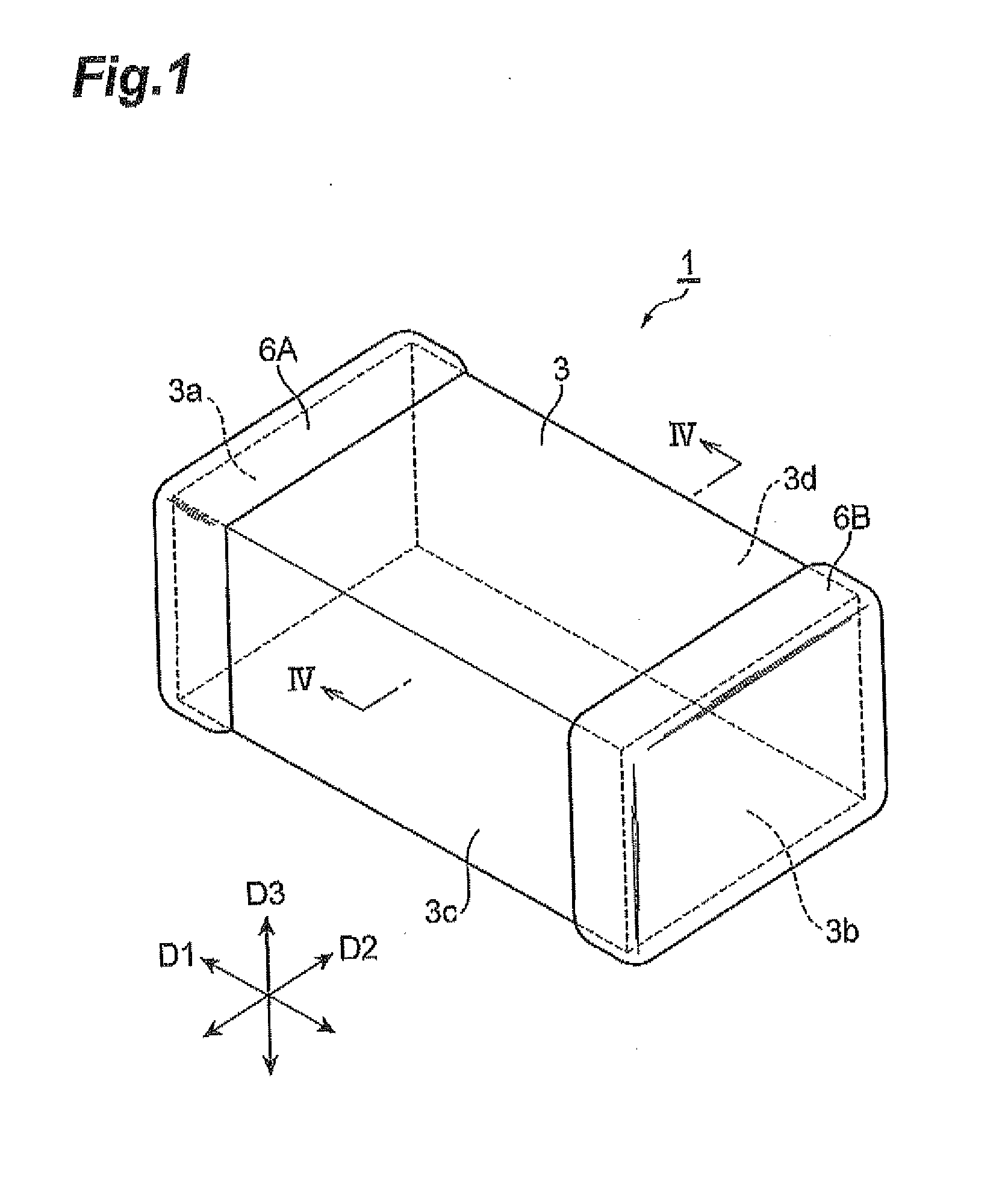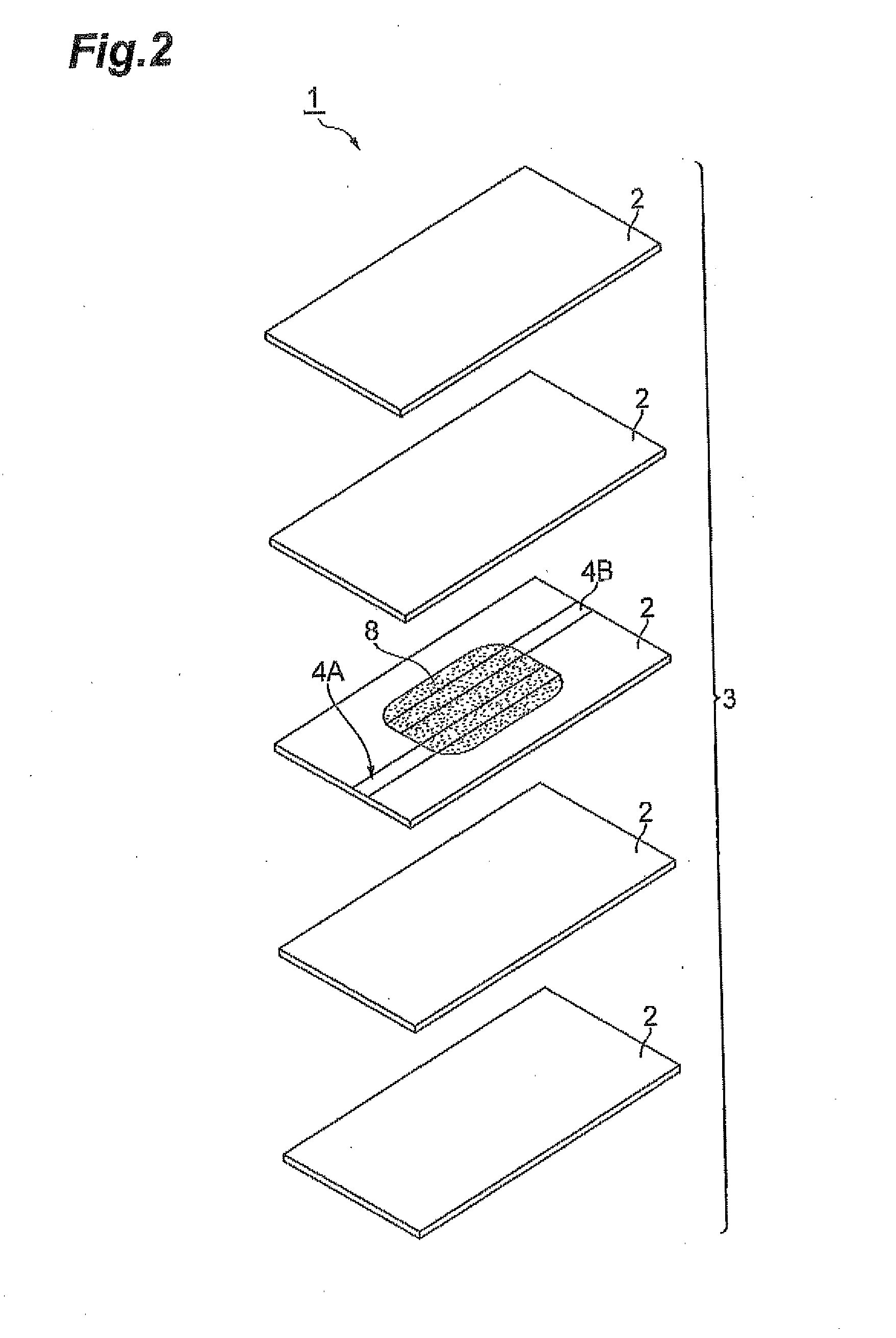Electrostatic protection component
a technology of electrostatic protection and components, applied in the direction of shielding materials, structural fixed capacitor combinations, relays, etc., can solve the problems of reducing the inability to increase the durability of the electrostatic protection component, and the electrode to be separated, so as to increase the size of the space region in the vicinity of the discharge portion, increase the durability of the electrostatic protection component, and reduce the clamp voltage
- Summary
- Abstract
- Description
- Claims
- Application Information
AI Technical Summary
Benefits of technology
Problems solved by technology
Method used
Image
Examples
first embodiment
[0080]FIG. 1 is a perspective view of an electrostatic protection component according to a first embodiment. FIG. 2 is a developed perspective view of a body of the electrostatic protection component according to the first embodiment. FIG. 3 is a diagram of a discharge portion of the electrostatic protection component when viewed in a direction of lamination. In FIG. 3, ceramic substrates 2 that are placed by one sheet on discharge electrodes 4A and 4B are shown being omitted. FIG. 4 is an enlarged cross-sectional view of the discharge portion taken along line IV-IV shown in FIG. 1. In the following description, a direction in which the body 3 extends is referred to as a longitudinal direction D1, a direction perpendicular to the longitudinal direction D1 in a direction of a flat surface of the ceramic substrates 2 is referred to as a short direction D2 and a direction in which the ceramic substrates 2 are laminated is referred to as a lamination direction D3.
[0081]The electrostatic...
second embodiment
[0140]FIG. 16 is a perspective view of an electrostatic protection component according to a second embodiment. FIG. 17 is a developed perspective view of a body of the electrostatic protection component according to the second embodiment. FIG. 18 is a plan view of a discharge portion of the electrostatic protection component when viewed in a direction of lamination. In FIG. 18, ceramic layers 402 on first and second discharge electrodes 404A and 404B and the like are omitted. FIG. 19(a) is a diagram for illustrating a cross-sectional configuration taken along line XIXa-XIXa shown in FIG. 18; FIG. 19(b) is a diagram for illustrating a cross-sectional configuration taken along line XIXb-XIXb shown in FIG. 18. FIG. 20 is a diagram for illustrating a cross-sectional configuration taken along line XX-XX shown in FIG. 16. In the following description, a direction in which a body 403 extends is referred to as the longitudinal direction D1, a direction perpendicular to the longitudinal dire...
third embodiment
[0183]An electrostatic protection component 401a according to a third embodiment will now be described with reference to FIGS. 25 and 26. As in the second embodiment, the electrostatic protection component 401a according to the present embodiment includes the body 403, the discharge electrodes 404A and 404B and the external electrodes 406A and 406B; the electrostatic protection component 401a differs from that of the second embodiment in that the electrostatic protection component 401a includes one discharge-inducing portion 438 and a hollow portion 437 formed on the discharge-inducing portion 438.
[0184]The discharge-inducing portion 438 is approximately rectangular as viewed in the lamination direction D3, and has the function of connecting the first and second discharge electrodes 404A and 404B to facilitate the occurrence of discharge between the first and second discharge electrodes 404A and 404B. The discharge-inducing portion 438 is formed so as to contact an approximate centr...
PUM
 Login to View More
Login to View More Abstract
Description
Claims
Application Information
 Login to View More
Login to View More - R&D
- Intellectual Property
- Life Sciences
- Materials
- Tech Scout
- Unparalleled Data Quality
- Higher Quality Content
- 60% Fewer Hallucinations
Browse by: Latest US Patents, China's latest patents, Technical Efficacy Thesaurus, Application Domain, Technology Topic, Popular Technical Reports.
© 2025 PatSnap. All rights reserved.Legal|Privacy policy|Modern Slavery Act Transparency Statement|Sitemap|About US| Contact US: help@patsnap.com



